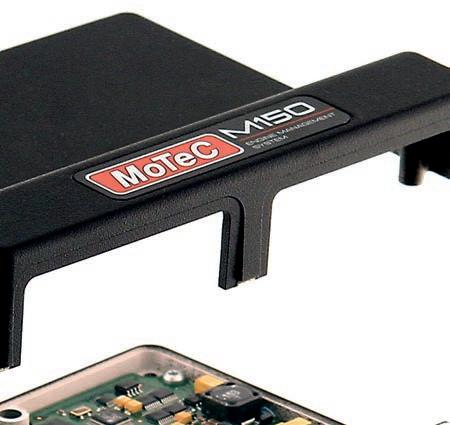
14 minute read
Engine control units
Standalone ECUs like MoTeC’s M150 have become commonplace in racing applications, allowing teams to customise their control strategies

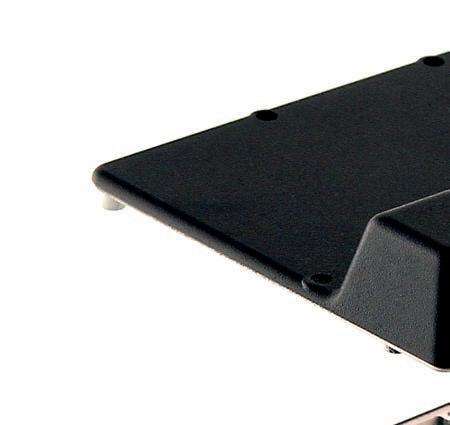
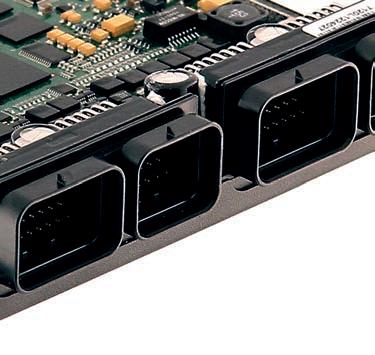
Strategic command
ECUs have come a long way in the last 40 years. Racecar looks at the developments that have led to a new de nition of the word ‘tuner’
By TOMMY PARRY
The advancements in engine control units (ECUs) over the last 40 years have played a large part in re-shaping the tuning and vehicle control landscape. Not only have developments in this fi eld made contemporary racing and production engines more effi cient and more tractable, but the modern ECU off ers failsafes, accurate systems modelling, greater systems integration and a range of other features that require evermore focus and attention from the systems calibrator. What we used to call a tuner.
In this article, we look at some of the recent developments in ECUs that have broadened their range of applications, as well as some of today’s more intriguing calibration challenges.
Basically, the ECU consists of a processor that uses a pre-programmed map that monitors inputs and controls its outputs thousands of times per second, off ering precise control of the fuel injection and ignition of a modern engine.
In slightly more detail, the ECU contains a printed circuit board (PCB), upon which microcontroller chips and the central processing unit (CPU) are mounted. The software is stored in fl ash memory. Thirty-odd years ago, a simple software update required replacing the chip, but advancements in fl ash memory made in the 1990s now allow for re-programming of the chip without altering the physical make up of the ECU.
Control centre
In addition to monitoring the position of the engine, fi ring of the ignition coils and fuel injectors, the ECU has taken on many other roles over the years. These days, it acts as a complete vehicle control unit. Various inputs are typical in modern ECUs, and can be classifi ed into several basic groups. These include digital inputs, analogue inputs and communication inputs like RS232 or CAN. Examples of typical analogue inputs are variable resistors like temperature sensors, potentiometers, switches and voltage generators.
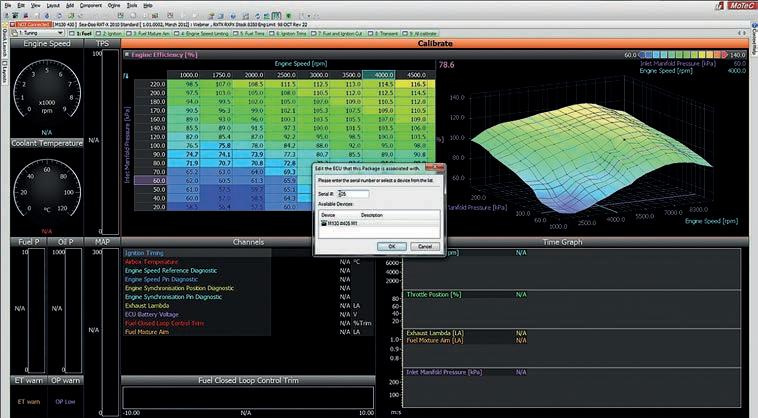
A straightforward interface, broad view of parameters and the ability to modify values in real time make MoTeC’s M1 Tune popular
Magnetic / Hall-effect sensors are a frequently used type of digital input.
This information is then directed by the ECU towards a multitude of outputs. Some examples include open collector low current relay drivers, as well as halfbridge and full-bridge drivers that can directly control components like small motors. There are also high voltage injector drivers for modern direct injection, as well as communication-based outputs designed to interface with other modules via either CAN or Ethernet.
Modern demands for power, efficiency, traction management, aerodynamic adjustments and more complicated powertrains have increased the general number of sensors in any given racing vehicle. This means more inputs and outputs, which have forced the ECU’s processing power to grow proportionally.
Over the last two decades, the ECU has made strides forward in two particular areas. The number of controllable elements has grown, as has the speed with which the ECU responds, largely due to increased processing power and improved programming capabilities.
Additionally, this has allowed teams of relatively small size to write custom algorithms into the code for their ECUs. Not surprisingly, greater access to something which OEMs once held dominion over has changed the game.
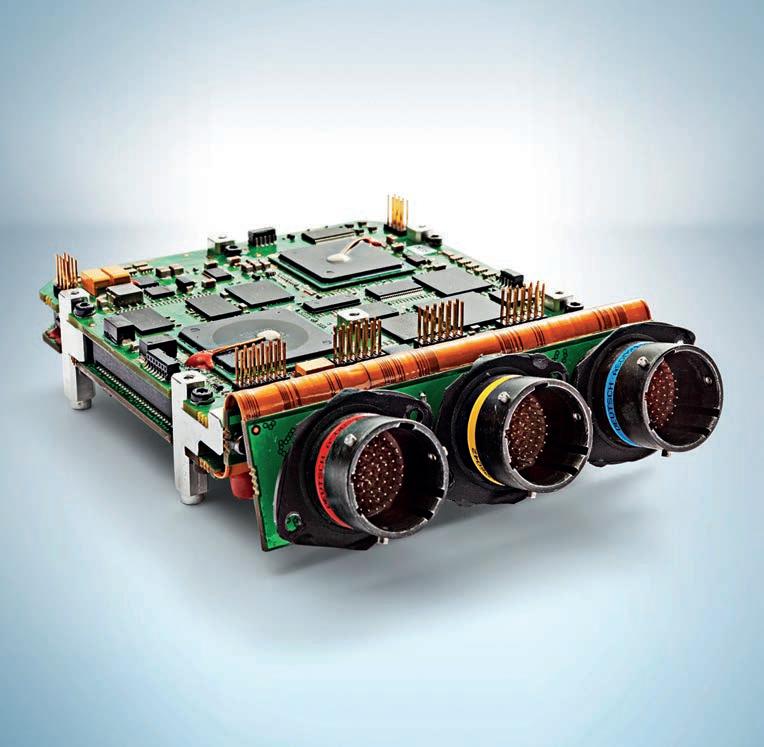
Intuitive interface
ECU tuning once entailed purchasing an ECU with pre-set tables and parameters that were mostly fixed. Some would offer very limited flexibility to create custom tables with user-defined axes, but truly customisable control systems implementation was not readily available.
Now, the working environment has expanded by offering the end user, or their calibrator, the opportunity to shape their own code and write their own control strategies. MoTeC’s M1 Build is just one example that has grown in popularity over the last decade.
M1 Build allows the tuner to make custom channels, parameters and tables all in their own custom control strategies. Within this development environment, privateers now have the ability to finish one-off projects within short time frames, and without the need to hire a dozen engineers.
This means small teams can avoid becoming mired in the myriad minor, but no less significant, jobs of low-level programming, building a microprocessor, de-bugging or just working in an environment not suited to motorsport.
Now, all privateers have to do is write simple snippets of code. They can then interface with drop-in sensors, tables, parameters and channels. All the unit conversions and common maths functions are provided, allowing the user to quickly implement their goal strategy without spending time worrying about the repetitive, mundane aspects of C-level programming.
‘Compare designing a control strategy to building a house,’ says Sasha Anis, general manager of MoTeC Canada and founder of Mountain Pass Performance, a tuning house specialising in EVs. ‘These
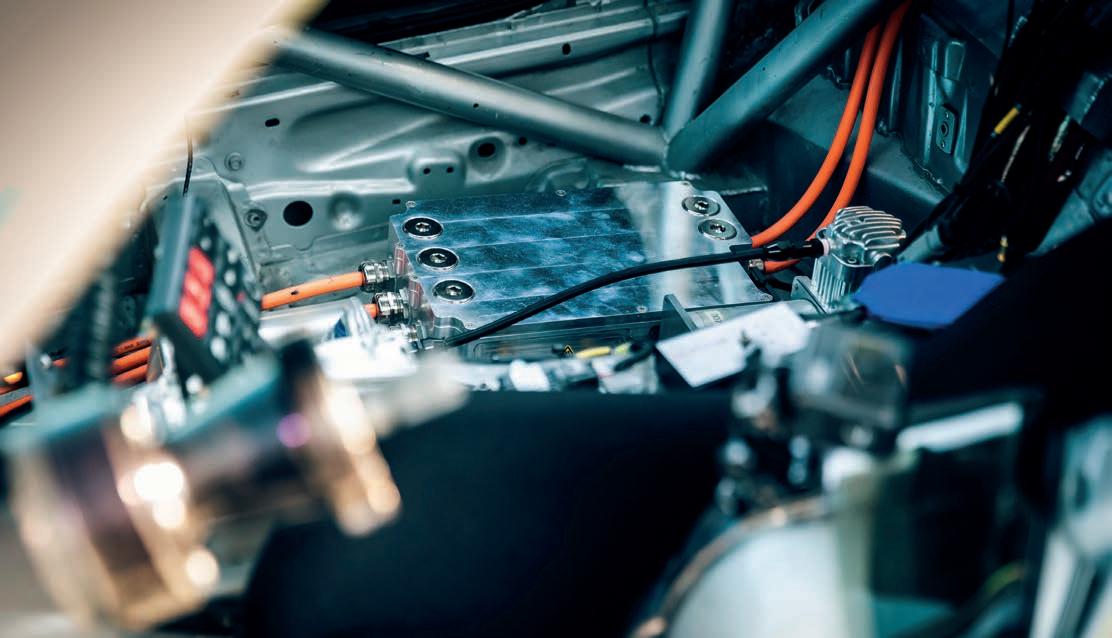
With hybrid units now commonplace in race series, ECUs have had to adapt and offer teams a higher level of flexibility to run these complex systems in tandem with internal combustion engines
ECUs allow you to buy the wood from the store, if you will, instead of having to grow the trees and mill the wood yourself. Basically, it gives the user the building blocks to create an effective control strategy paired with a high level of robustness.’
MoTeC’s M1 Build uses a tree structure to represent logical subsystems and define naming of these systems, which carry through to the tuning interface. The code is then compiled into a package, which is then loaded onto the ECU. In addition, there are pre-provided modules that can be used in a drag-and-drop fashion to quickly implement elements like common sensors, tables, parameters and communication modules.
Drag and drop
A user can drag and drop these modules into their own bespoke tree structure to create their own ECU subsystems.
‘Essentially, the user can now devise their own control strategy, while still benefiting from the safeguards of the system,’ continues Anis. ‘It won’t allow you to break the core function of the ECU. You can still have logic errors, but you won’t fundamentally take down the ECU.
‘You just drop in a table, and it does all the necessary interpolation, limit checking and value validation for you.’
With M1 Build, the user is given access to the code. If they need to write a specific module to run the car, the user can drop into a modularised interface mode and write the code and make their own firmware. Following this, the user will use MoTeC’s M1 Tune to move forward.
M1 Tune is software that provides the user the ability to interface with the firmware developed in M1 Build. In M1 Tune, the user can look at all the parameters and tables and modify the values in real time, just as one would expect of a modern ECU.
However, many motorsport outfits are now trying to design their control strategies in house, much like the OEMs. One program, Simulink, allows teams to run control strategies in a flow chart style. They add the various blocks, and Simulink compiles these blocks into an application.
Simulink’s popularity has expanded its use in everything from FSAE programmes to Bosch ECUs used at the higher end of motorsport. This is due to two traits: its intuitive interface and its modular code.
‘Simulink doesn’t require you to be skilled in C-based code,’ says Hannah Westbrook, an engineer for Honda Performance Development, who started using the program at university and participating in its FSAE initiative. This accessibility is largely due to Simulink’s block-based diagrams. Its intuitive interface shows each block representing an easily comprehensible value such as greater than, less than or equal to. This allows programmers to put together strategies without writing code-based statements.
‘When choosing between ECUs, you have to ask a lot of questions,’ says Westbrook. ‘How many sensors and analogue inputs do you need? What is the processing power required? Do you want to run your own injector or ignition box? The answers to these will narrow the options down to a few.’
Core skills
‘Then you ask how many cores can your processor run? If you’re limited by your number of cores, you have to ask them to balance tasks with other cores and, in turn, you spread them thinner. However, more processor function means more power, which means more heat.’
The list of considerations goes on, endlessly it seems. More sensors mean more wires, which adds to the overall weight. The user must then ask how much weight can be shed from other areas to achieve an overall target weight. Incidentally, there are Bluetooth sensors available now that can reduce wiring weight, but their number is often limited by the regulations for safety reasons.
Weight can also be reduced by running CAN expansion boxes, which often require a larger collection of shorter wires, with only two wires between the expansion and the main ECU. This reduces weight, but this also increases the processing power demands as CAN is more processor heavy than analogue signal sampling, and the more sensors added on CAN, the more CAN buses needed. As they say, there’s no such thing as a free lunch.
The engineer’s preferences and past experience also play a part in the decision making process. ‘For instance, how is the ECU programmed (Simulink, etc)? Who do you have a good working relationship with? Though these considerations aren’t always primary factors in deciding which ECU is used, they do make a difference in softening the slope of the learning curve,’ Westbrook adds.
The processing power and sheer number of channels being worked with in real time with modern ECUs has grown enormously in recent years. So much so, in fact, that Ethernet is now necessary for effective communication between ECUs.
Telemetry channels in the modern racecar are now transferred via an RS232 signal or an Ethernet signal, with the occasional CAN bus signal. On the other end of it, as long as there’s a decent connection, there’s a telemetry server needed to receive and decrypt that information.
Getting information from the car to the pit stand has been made much better with 4G technology, though the activity of the crowd on their ’phones and tablets still compete. It really depends on the configuration of radio towers around the track.
Password protection is nothing new with ECUs, and there are a number of scrutineering programs that enable detailed file overlays to reveal any tampering. Still, there are a great number of clever saboteurs out there. To further safeguard information, a metadata file is used. Competing teams cannot spectate a telemetry stream if they don’t have the necessary metadata file.
Other safeguarding measures include an encryption key that, even if it’s visible, the data stream is indecipherable without.
The hybrid challenge
With the widespread interest and prevalence of hybrid powertrains currently, most popular ECUs in high-level motorsport will need the versatility to handle the additional challenges posed by electric motors.
Now with Honda Performance Development, Westbrook is involved with systems integration of LMDh hybrid cars for IMSA competition. These cars run a Bosch MCU (Motor Control Unit) and MGU (Motor Generator Unit), both of which are series mandated. However, the McLaren ECU strategy with the hybrid system integration is still largely up to the team to design and compile.
There are different strategies to deploy and regen’ the hybrid power and, thankfully, it has some flexibility so the manufacturers can continue to refine their control strategies. However, that does not change the fact that these systems are highly complex and, in order to run them, many considerations must be made.
Considering the inherent dangers of working with high voltage systems, the BMS (Battery Management System) needs to be extremely thorough in monitoring cells and high voltage isolation from the rest of the chassis. Not surprisingly, this also requires many sensors.
Additionally, ancillary systems must be monitored extra carefully when dealing with regen’ and deployment.
‘With an EV, you have to be cognisant of when you deploy the energy and ensure it will not compromise a related area. For instance, will the braking system handle the extra challenges of harvesting?’ Westbrook queries.
‘After the driver’s requested brake pressure value is sent to the electronic braking system, it will take that value and split it between the MGU and the brakes. We must ensure the proportion of brake pressure used to slow the car will always be sufficient,’ she explains.
Beyond ensuring safety, the ECU’s general aim in this environment is achieving greater efficiency. And to do this, elements like the MGU and the ICE must be kept operating in their own ideal efficiency ranges.
‘How the algorithm is written in this instance is vital, since getting the two to

The inherent danger present in any high-voltage system means the cells must be closely monitored at all times

An inverter, DC DC converter and power distribution module mounted inside a hybrid Time Attack car
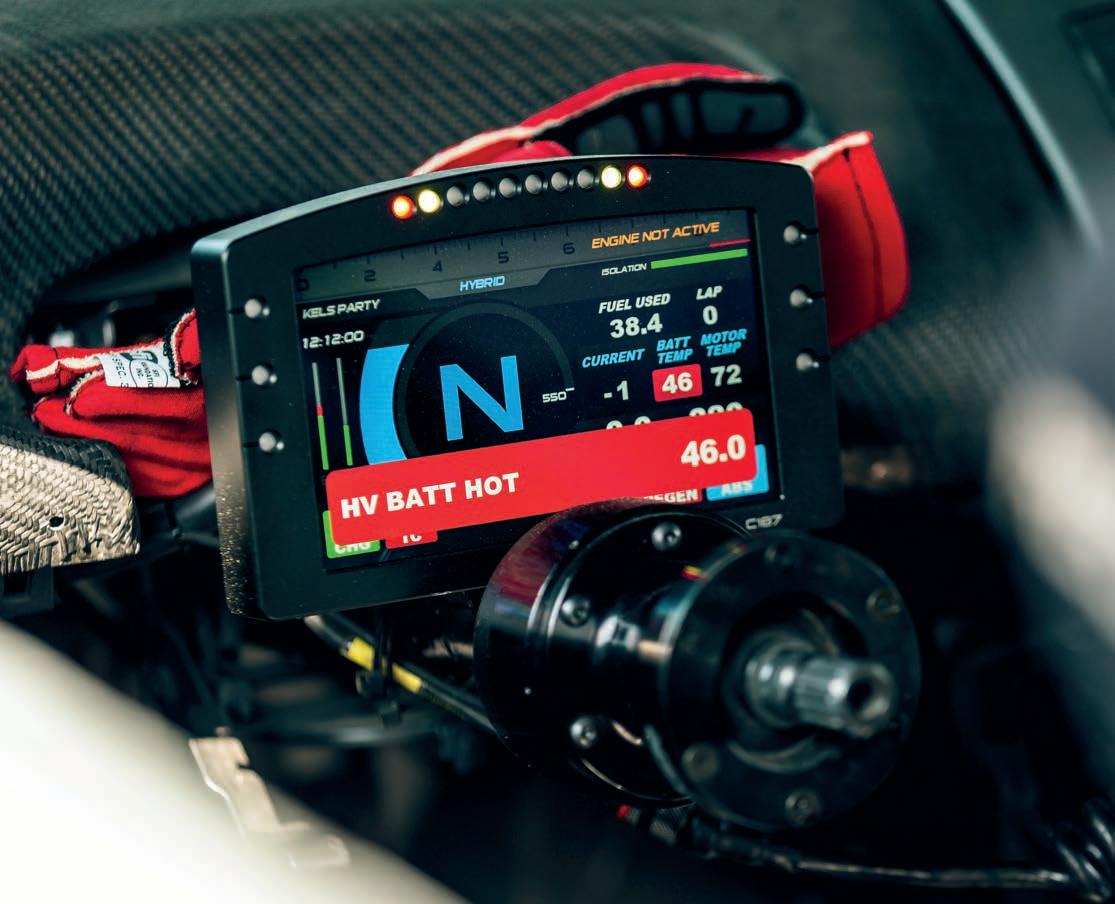
Keeping the driver abreast of battery conditions is an essential part of running a hybrid racecar, and the ECUs onboard have to monitor this and respond to different torque requests on the go
communicate clearly requires a lot of careful implementation,’ adds Westbrook. This is obvious when discussing the trade off taking place when a mildly compromised hybrid has to deliver a torque request.
For instance, the BMS monitors battery parameters so, if the battery becomes too hot, it changes the maximum allowed charge and discharge rate. The BMS then informs the ECU so it can adjust its strategy. In further detail: in order to make sure the ICE and the electric motor respond well to a torque request when battery power dwindles and cannot provide the desired amount of electric power, or if the system is harvesting and not able to fully deploy, the torque request will have to ask the combustion engine to compensate for the electric motor’s reduced offering and meet the torque request. This feature plays a large part in determining an EV’s stamina over a long haul.
Future innovations
‘What do I think we might see in the future? Well, with EV in motorsport, the engine might soon become the part responsible for the ‘push-to-pass’ function, while the electric motor will play a larger part in providing the thrust,’ says Westbrook.
On the electronics side, there may soon be a ‘central box’ responsible for handling most duties, while ancillary duties, say injector drivers, will be sent on CAN via a specialised ‘injector box’. This relieves the central box of certain duties that could be delegated in the name of greater efficiency.
This could help both the manufacturers and the customers. Not only could it be easier for the manufacturers to build these bespoke boxes, but it would allow the customer a more modular and customisable product.
Will modern ECUs make it easier for alternative fuels to be embraced? ‘Absolutely,’ declares Westbrook. ‘The foundation has already been laid and ECUs can easily adapt to these changes. Most of the necessary sensors are already onboard, so the concerns would be primarily around pressures and whether the fuel system and cylinders could handle them.’
Advancements in electronics in the last 30 years have made customisation possible where it was once prohibitively expensive, or difficult to deploy. Systems such as fourwheel steering, DRS and EBS have all been made possible by the increase in processing power of ECUs. Now, with the ability to create custom control strategies, the landscape has opened up further still and a vast number of clever control strategies are now available to racers looking for a competitive edge.










